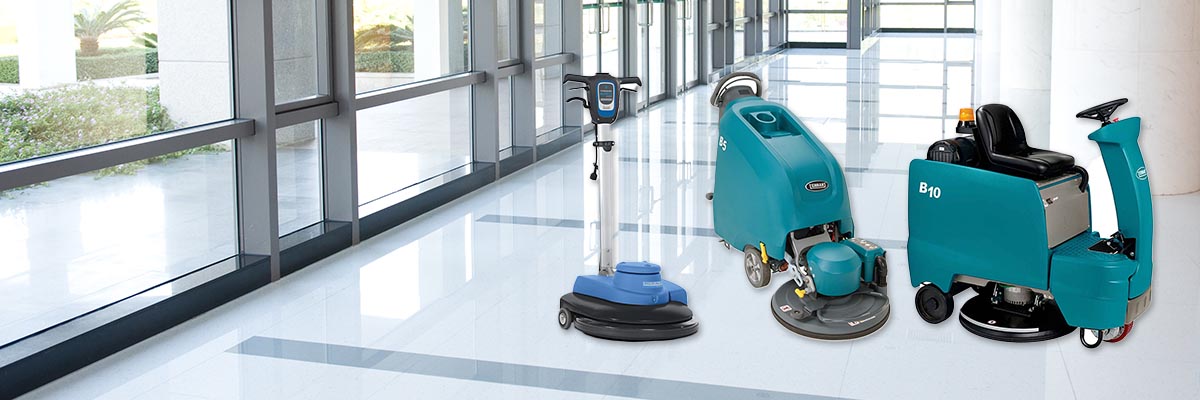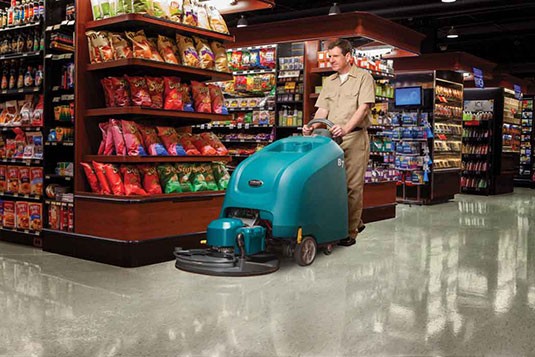The Professional's Guide to Floor Burnishing: Restoring Shine and Durability
Floor burnishing is an important process in facility management to help maintain high standards of cleanliness and floor appearance. By incorporating burnishing into your floor care program, you can achieve a “wet-look” shine, enhancing the floor’s aesthetic appeal and making it easier to maintain.

Burnishing is a high-speed process that brings out the floor’s natural shine by eliminating surface imperfections. As a result, it’s an excellent solution for facility managers seeking a durable, professional finish on their resilient tile or terrazzo floors.
What Burnishing Does
Burnishing uses high-speed equipment to achieve a polished, glossy look on hard floors. The burnisher’s high-speed pass smooths the surface by removing minor scratches and imperfections. This smoothing effect reduces areas where dirt and grime typically settle, enhancing the floor’s resistance to dust and debris. Ultimately, burnishing is an efficient method to ensure floors look clean, attractive, and resilient against wear.
Burnishable vs. Non-burnishable Floor Finishes
Not all floor finishes are suitable for burnishing; some finishes are designed to withstand the high-speed process, while others are not. When uncertain, check with the manufacturer to confirm if your floor finish is suitable for burnishing. Testing in a small, inconspicuous area is always recommended to ensure the finish responds well to the process.
Types of Burnishers
Corded Burnishers
Corded burnishers are plug-in machines that provide consistent power throughout the burnishing process. They offer reliable performance for areas near power outlets but can be limited by cord length, making maneuverability a challenge in larger spaces. Corded burnishers are often cost-effective and dependable for small to medium spaces.
Recommended Product: Trident BU1500 Corded Burnisher
Battery Burnishers
Battery burnishers provide greater flexibility since they are not restricted by cords, making them ideal for larger or more open areas. They offer similar power to corded burnishers but may require periodic recharging, which can impact productivity. Battery burnishers are well-suited for facilities where access to outlets is limited.
Recommended Product: Tennant B5, 20" Walk Behind Battery Burnisher
Recommended Product: Tennant B10, 27" Rider Battery Burnisher
Propane Burnishers
Propane burnishers are powerful and portable, often used for large facilities due to their high-speed capability and flexibility. They require fuel but can operate continuously without power cords or charging downtime. Propane burnishers are efficient for large-scale areas but may produce emissions, making ventilation necessary.
Burnishing Pads
Burnishing pads, built for the high-speed friction produced by burnishers, are essential for achieving a polished floor finish. These pads are used exclusively on clean floors to elevate the gloss level. Like other floor pads, burnishing pads come in varying levels of aggressiveness. Generally, lighter-colored pads are less aggressive, suitable for softer finishes, while more aggressive pads, often made with synthetic and natural fibers (like hog hair), are ideal for harder surfaces. Manufacturers’ color schemes can vary, so it’s best to check the pad’s specifications for optimal results.
Product Recommendations
- General use: Hillyard, Trident®, Luster Lite Burnish, Blue, 20", Round Floor Pad
- For soft to medium finishes: Hillyard, Trident®, Burnish, Beige, 20", Round Floor Pad
- For soft to medium finishes: Hillyard, Trident®, Champagne Burnish, Beige, 20", Round Floor Pad
- For hard finishes: Hillyard, Trident®, Porko Plus Burnish, Gray, 20", Round Floor Pad
- For higher solid, harder finishes, infrequent burnishing: Hillyard, Trident®, Porko Extreme Burnish, Black, 20", Round Floor Pad

How to Burnish
-
Prepare the Floor
Ensure the area to be burnished is free from obstacles. Remove any movable furniture and signage, allowing for a smooth, uninterrupted process. Check for any spills or substances that may interfere with burnishing.
-
Dust Mop or Vacuum the Area
Dust mopping or vacuuming will remove loose dirt and debris from the floor. This step is essential as it prevents dirt from being embedded into the floor during burnishing. Work methodically to cover the entire area and prevent leftover dust.
-
Clean the Floor with a Mop or Automatic Scrubber
A thorough cleaning with a mop or automatic scrubber will remove any remaining residue. Cleaning ensures that the burnisher has a clean surface to work with and prevents embedding soils into the floor finish. Allow the floor to dry completely before proceeding to burnish.
-
Burnish the Floor
Using your selected burnisher, make consistent passes over the floor to achieve a high-gloss finish. Be mindful of overlapping your passes slightly to prevent streaking and ensure an even polish. Check periodically to confirm that the desired shine level is achieved.
-
Clean Up Any Leftover Dust from the Process
After burnishing, there may be residual dust or polish on the floor. Use a dust mop or vacuum to remove any leftover particles. This final step ensures the area is pristine and ready for use.
Hillyard Can Help You Develop a Comprehensive Floor Maintenance Plan
Hillyard’s team of experts across the United States can assist you in developing a custom floor maintenance plan tailored to your facility’s needs. Our representatives are available to offer guidance on selecting the right equipment, pads, and procedures for achieving the best results. Whether you are implementing a new floor care program or updating an existing one, our expertise can help you maximize efficiency and prolong the life of your floors. Contact us using the form below, and a Hillyard representative will reach out to discuss your floor care goals. We are committed to supporting you in every aspect of your facility’s floor maintenance program.